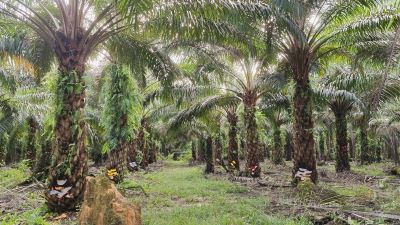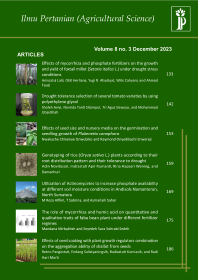
Physiological responses, growth and productivity of oil palm (Elaeis guineensis Jacq.) as affected by boron fertilization
Lukas Priyo Prasetiyanto(1*), Eka Tarwaca Susila Putra(2), Eko Hanudin(3)
(1) Faculty of Agriculture, Universitas Gadjah Mada
(2) Faculty of Agriculture, Universitas Gadjah Mada
(3) Faculty of Agriculture, Universitas Gadjah Mada
(*) Corresponding Author
Abstract
Boron (B) is an essential micro nutrient that is needed by oil palms, especially to control productivity. The aim of this research was to determine the optimal dose of B for mature oil palms. The research was conducted at a smallholder oil palm plantation located in Katingan Region, Central Kalimantan Province from January to December 2022. The field experiment was a single factor arranged in a Randomized Complete Block Design (RCBD) with three blocks as replications. The factor tested was the dose of B fertilization, consisting of five doses, namely 0 g. trunk⁻¹. semester⁻¹ (control); 25 g. trunk⁻¹. semester⁻¹; 50 g. trunk⁻¹. semester⁻¹; 75 g. trunk⁻¹. semester⁻¹; and 100 g. trunk⁻¹. semester⁻¹. Observations were done on several variables of micro-weather characteristics at the research site, nutrient and physiological characteristics of leaf, morphological characters and plant growth, and yield and yield components of oil palms. The data obtained were then analyzed with analysis of variance (ANOVA) α=5 %, and data showing significant differences between treatments were tested with an orthogonal polynomial. The results showed that B had positive effects on leaf B, P and K concentration and absorption, leaf chlorophyll content, number of midribs, plant height, leaf area per trunk, leaf area index, crop dry weight, pollen fertility, fruit set, pollen viability, fresh fruit bunch weight (FFB) and FFB productivity. The optimal dose of B to optimize oil palms productivity was 60.24 g. trunk⁻¹. semester⁻¹ with a maximum value of FFB productivity of 6.94 tons. trunk⁻¹. semester⁻¹.
Keywords
Full Text:
PDFReferences
Basiron, Y. (2007). Palm oil production through sustainable plantations. European Journal of Lipid Science and Technology, 109(1), pp. 289−295.
Central Bureau of Statistics Indonesia. (2020). Indonesian Palm Oil Statistics 2019. Jakarta.
Corley, R. H. V., and Tinker, P. B.(2016). The Oil Palm. Fifth edition. UK: Willey Blackwell Sciences.
Goldbach, H. E., and Wimmer, M. A. (2007). Boron in plants and animals: is there a role beyond cell-wall structure?. Journal of Plant Nutrition and Soil Science, 170(1), pp. 39–48.
Gupta, U., and Solanki, H. (2013). Impact of boron deficiency on plant growth. International Journal Bioassays, 2(7), pp. 1048−1050.
Han, S., Chen, L. S., Jiang, H. X., Smith, B. R., Yang, L. T., and Xie, C. Y. (2008). Boron deficiency decreases growth and photosynthesis, and increases starch and hexsoses leaves of citrus seedling. Journal of Plant Phsiology, 165(13), pp. 1331–1341.
Hapuarachchi, N. S., Kämper, W., Wallace, H. M., Bai, S. H., Steven, Nichols, M. O. J., and Trueman, S. J. (2022). Boron effects on fruit set, yield, quality and paternity of hass avocado. Agronomy, 12(1479), pp. 1–15.
Hardon, J. J., Williams, C. N., and Watson, I. (1969). Leaf area and yield in the oil palm in Malaya. Experimental Agriculture, 5(1), pp. 25–32.
Jacquemard, J. C., Suryana, E., Kurnia, D., and Talliez, B. (2006). Expression of boron deficiency symptoms and link with the genotype in oil palm (Elaeis guneensis Jacq.). Communication presented at IOPC.
Legros, S., Serra, I. M., Caliman, J. P., Siregar, F. A., Vidal, A. C., and Dingkuhn, M. (2009). Phenology and growth adjustments of oil palm (Elaeis guneensis Jacq.) to photoperiod and climate variability. Annals of Botany, 104(1), pp. 1171–1182.
Mahendra, E., and Hasnelly. (2019). Growth response and yield of oil palm plants (Elaeis guineensis Jacq.) TM 15 with dosing of Borat fertilizer. Journal of Agroscience, 4(2), pp. 1−7.
Patil, P., Briradar, P., Bhagawathi, A. U., and Hejjegar, I. S. (2018). A riview on leaf area index of horticulture crops and its importance. International Journal of Current Microbiology and Applied Sciences, 7(4), pp. 505–513.
Srisook, N., Oramon, T., Danphitsanuparn, P., Pattana-anake, V., and Joseph, S. J. J. (2022). Convolutional neural network based nutrient deficiency classification in leaves of Elaeis guineensis Jacq. International Journal of Computer Information Systems and Industrial Management Applications, 14(1), pp. 19–27.
Statista Research Department. (2022). Vegetable oils consumption per capita in Indonesia from 2010 to 2020, with estimates until 2030. [online] Available at: https://www.statista.com/statistics /1225403/indonesia-vegetable-oils-consumption -per-capita/. [Accessed 4 May 2022].
Sutarta, E. S., and Syarovy, M. (2019). Soil fertility and photosynthesis rate of oil palm plants that show symptoms of white stripe on peatlands in labuhan batu. Journal of Palm Oil Research, 27(2), pp. 127−140.
Trivedi, N., Singh, D., Bahadur, V., Prasad, V. M., and Collis, J. P. (2012). Effec of foliar application of zinc and boron on yield and fruit quality of guava (Psidium guajava L.). Horti Flora Research Sepectrum, 1(3), pp. 281–283.
Article Metrics
Refbacks
- There are currently no refbacks.
Ilmu Pertanian (Agricultural Science) ISSN 0126-4214 (print), ISSN 2527-7162 (online) is published by Faculty of Agriculture Universitas Gadjah Mada collaboration with Perhimpunan Sarjana Pertanian Indonesia (PISPI) and licensed under a Creative Commons Attribution-ShareAlike 4.0 International License.














